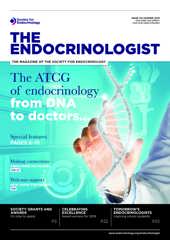The majority of thyroid cancers are differentiated, originating from follicular thyroid cells. They usually present as a lump in the neck or may be found incidentally during investigation of unrelated neck disorders, including carotid Doppler and cross-sectional imaging approaches.
Thyroid nodules (lumps) are very common and occur in at least 50% of the population. However, only a small subgroup (5–7%) harbour a clinically significant cancer. The initial evaluation of thyroid nodules includes thyroid function testing, to ensure this is normal, and an ultrasound assessment. There are a number of scoring systems which combine suspicious ultrasonographic features such as solid composition, hypoechogenicity, irregular margins, increased intra-nodular blood flow and the presence of micro-calcifications to predict the risk of malignancy.
Nodules that cannot be deemed benign through ultrasonography need to be further investigated through fine needle aspiration cytology (FNAC), to help determine the possible presence of thyroid malignancy.1
INDETERMINATE THYROID NODULES
Around 20–30% of cytological evaluations result in indeterminate results and usually encompass RCPath Thy3a (neoplasm possible with cellular atypia) and Thy3f (follicular neoplasm suspected), which have an overall risk of malignancy of 10–30% and 25–40% respectively.
Generally, patients with indeterminate nodules undergo surgery to remove the half of the thyroid gland that contains the thyroid nodule for full pathological evaluation, to exclude thyroid malignancy. The use of molecular testing of FNAC specimens to refine the diagnosis of thyroid malignancy has become widely accepted in the USA and in some European centres.2
GENETIC ALTERATIONS
The molecular alterations underlying thyroid cancer have been unravelled for about 95% of differentiated tumours. Papillary thyroid cancers, which account for about 85% of all thyroid cancers, usually occur following mutations in genes coding for proteins in the mitogen-activated protein kinase (MAPK) pathway, which regulates the proliferation and differentiation of thyroid cells. A single mutation in the BRAF gene (V600E) is found in up to 60% of papillary cancers, as well as in more rare poorly differentiated and anaplastic cancers, which originate from papillary cancers following a de-differentiation process. Mutations in RAS genes are found in 15% of papillary cancers and in 40% of follicular cancers, which also belong to the group of differentiated cancers, accounting for 2–5% of all thyroid cancers.3
Hybrid genes, formed following fusion of two previously unrelated genes, such as the RET/PTC oncogene and the PAX8/PPARG gene, are found in radiation-induced papillary cancers and in some follicular thyroid tumours. More recently, mutations in the telomerase reverse transcriptase (TERT) gene and in the TP53 tumour suppressor gene have been described in some differentiated tumours, but also, in particular, in undifferentiated and anaplastic thyroid tumours.3
MOLECULAR TESTING STRATEGIES
The two most commonly used approaches to evaluate the molecular background of thyroid cancers are mutational analysis and gene expression analysis.
In mutational analysis, the DNA from the material obtained through fine needle aspiration biopsy of the thyroid nodule is sequenced to look for mutations in BRAF, RAS, TERT, TP53 and other relevant genes, as well as to detect fusion genes.4 If a mutation in these genes is found, then thyroid cancer is almost always present, and this type of testing is therefore called a ‘rule-in’ test.5 However, RAS mutations may be present in benign thyroid lesions and driver mutations are unknown for about 5% of differentiated cancers, so false-positive and false-negative results may occur. Nonetheless, this approach offers further advantages because the determination of BRAF- and RAS-positive status also has prognostic value in addition to diagnosing thyroid malignancy. BRAF-positive tumours are more aggressive whereas RAS-positive cancers tend to have a more indolent behaviour.6
Gene expression analysis or gene expression classifiers use algorithm-type approaches to analyse the expression of specific genes in panels of 142 genes.7 Nodules are classed as benign or suspicious, with those identified as benign not requiring surgery. This is therefore a ‘rule-out’ test, and a pooled analysis of 12 studies concluded that the negative predictive value of the gene expression classifier is 92%, with a malignancy prevalence rate of 31%, in the nodules that were studied.8
A further approach to diagnose the presence of malignancy is the determination of expression of microRNAs, which are small non-coding RNA fragments that regulate gene expression by influencing the stability and translation of messenger RNA. MicroRNAs are relatively stable compared with messenger RNA and are differentially expressed in benign and cancerous thyroid tissues. Two commercially available kits based on microRNA expression in thyroid fine needle aspiration biopsies are currently in use.9
MOLECULAR TESTING IN THE NHS
Molecular testing to avoid unnecessary surgery in patients with indeterminate thyroid nodules is expensive, ranging from $3000 to $5000 depending on the test used. The most studied tool evaluated on health economic grounds is the gene expression classifier, indicating this to be a cost-effective test.10 However, most of these cost-effectiveness analyses are based on modelling rather than actual patient data, and results are dependent on the malignancy rates in the population, costs of surgery and surgical complications, healthcare costs and a number of other factors.
Whilst these molecular analyses are likely to result in reductions in unnecessary surgery and patient benefit, the high cost of testing makes the routine use of these approaches prohibitive in our current NHS system.
Kristien Boelaert, Reader in Endocrinology, Institute of Metabolism and Systems Research, University of Birmingham
REFERENCES
- Durante C et al. 2018 JAMA 319 914−924.
- Haugen BR et al. 2016 Thyroid 26 1−133.
- Fagin JA & Wells SA Jr 2016 New England Journal of Medicine 375 2307.
- Nikiforov YE 2017 Endocrine Practice 23 979−988.
- Eszlinger M et al. 2017 Nature Reviews Endocrinology 13 415−424.
- Kakarmath S et al. 2016 Journal of Clinical Endocrinology & Metabolism 101 4938−4944.
- Alexander EK et al. 2012 New England Journal of Medicine 367 705−715.
- Al-Qurayshi Z et al. 2017 JAMA Otolaryngology – Head & Neck Surgery 143 403−408.
- Nishino M & Nikiforova M 2018 Archives of Pathology & Laboratory Medicine 142 446−457.
- Labourier E 2016 Clinical Endocrinology 85 624−631.






